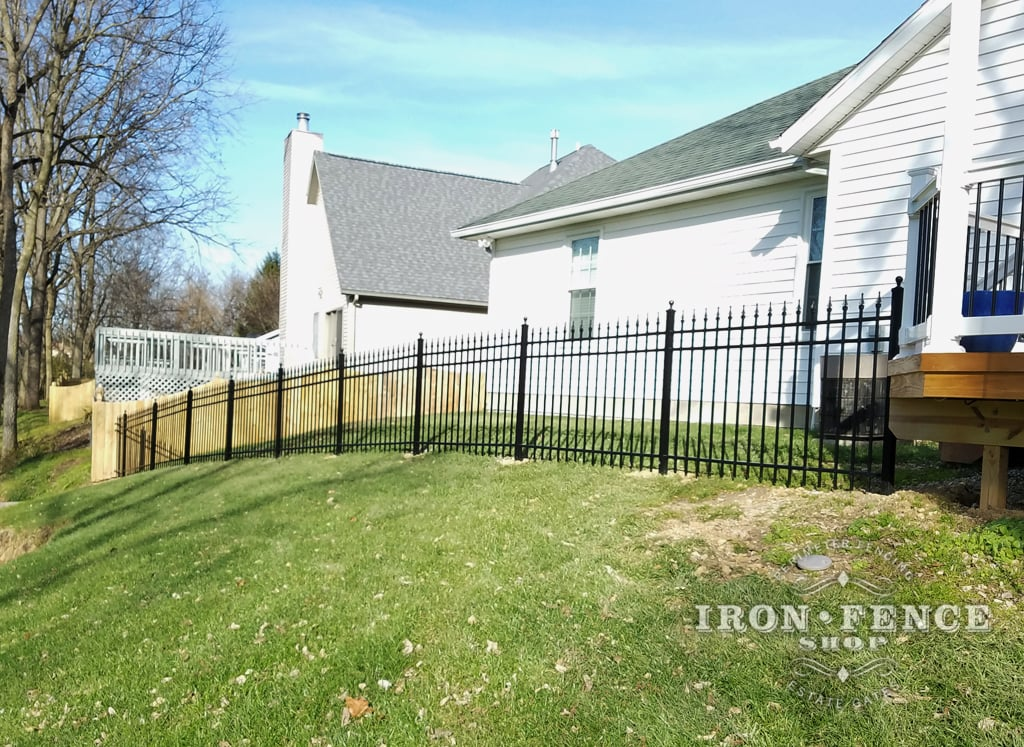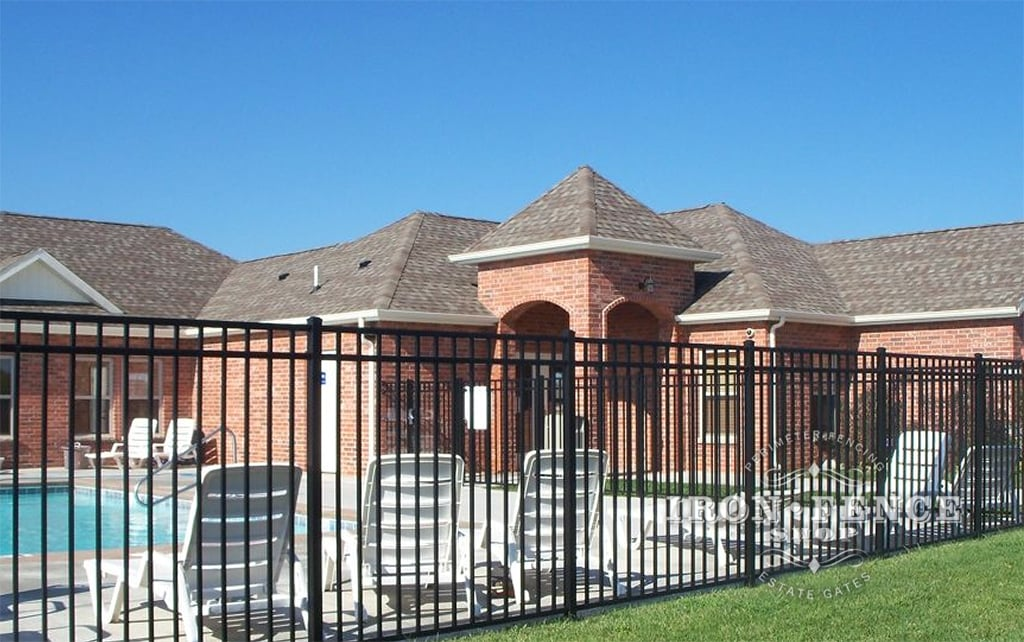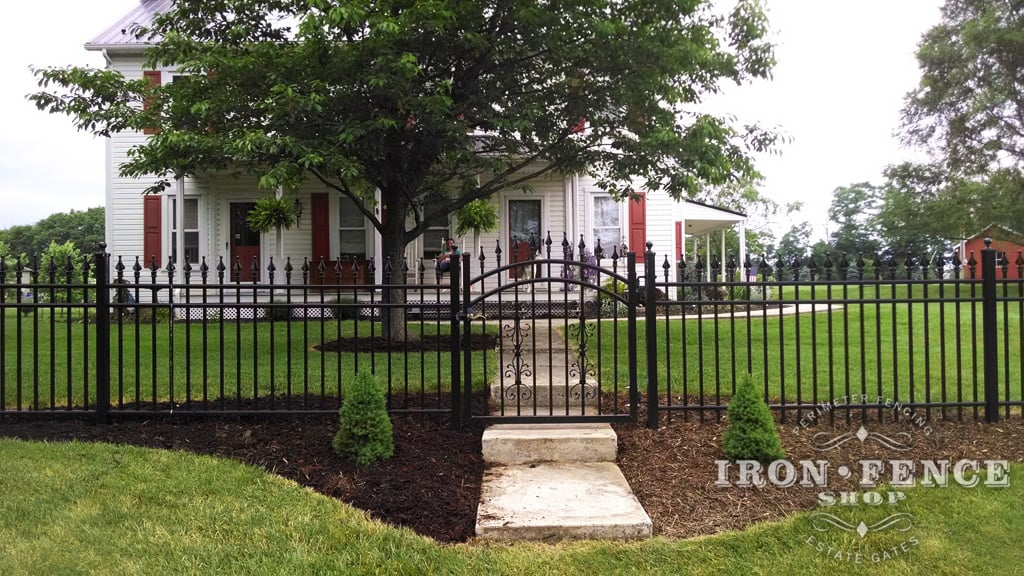
Choosing the right fencing material for your property can be daunting. Aluminum and vinyl are two of the most popular fencing options. Each offers unique benefits and challenges, making the decision largely dependent on your needs and preferences.
In this article, we’ll explore the key differences between aluminum and vinyl fencing, comparing durability, maintenance, and other aspects to help you determine which option is better suited for your home or business.
Material Composition of Vinyl and Aluminum Fence Panels
Aluminum and vinyl fences differ significantly in their material composition, influencing their performance, durability, and aesthetic appeal. Understanding these differences can help you make an informed decision between the two.
Aluminum Fences
Aluminum fences are typically made from high-grade aluminum alloys, which are chosen for their strength, lightweight nature, and corrosion resistance. The aluminum is often powder-coated to enhance durability and provide various color options.
Iron Fence Shop uses only the highest-grade aluminum alloys to ensure exceptional strength and longevity, using a TGIC fade-resistant polyester powder coat.
Aluminum is also known for its excellent strength-to-weight ratio, making it a robust yet lightweight option for fencing. It is non-ferrous, meaning it does not rust, a significant advantage in humid or coastal environments. The powder coating adds to the aesthetic appeal and provides additional protection against the elements.
Vinyl Fences
Vinyl fence panels are made from polyvinyl chloride (PVC), a type of plastic known for its durability and resistance to environmental factors. The PVC used in fencing is often reinforced with additives that enhance its strength and UV resistance.
Vinyl is also a highly durable material that does not warp, rot, or splinter, making it an excellent choice for long-term use. It is also resistant to pests and does not require painting or staining, which reduces maintenance needs. The material is available in various colors and styles, allowing customization to suit different aesthetic preferences.
Both aluminum and vinyl fences offer unique advantages based on their material composition. Aluminum’s strength and corrosion resistance make it ideal for durability, while vinyl’s low maintenance and aesthetic versatility make it a popular choice for residential applications.
Understanding these material differences is crucial in selecting the right fence for specific needs and environmental conditions.
|
HOA Approval: Check with your homeowner’s association before selecting a fence, as some communities have restrictions on materials, colors, or heights. |
Maintenance Requirements for Aluminum and Vinyl Fences
Maintaining aluminum and vinyl fences is key to preserving longevity and curb appeal. While both materials are known for requiring far less upkeep than traditional wood fencing, each comes with its own set of maintenance best practices.
Understanding these differences will help homeowners keep their fences looking great and functioning properly for years.
Aluminum Fence Maintenance
Aluminum fences are naturally resistant to rust and corrosion and require only basic upkeep. A quick rinse with water helps clean surfaces, while occasional washing with mild soap removes deeper grime.
Periodic inspections are important to catch loose screws or damaged hardware. These should be tightened or replaced promptly to avoid structural issues.
While not necessary, applying a protective wax coating can improve resistance to weathering and extend the life of the fence’s finish.
Vinyl Fence Maintenance
Vinyl fences are prized for their no-paint, no-stain maintenance. Regular cleaning with a garden hose is usually sufficient. For tougher dirt or build-up, a soft brush and soap will restore the surface without damaging it.
To prevent damage, avoid abrasive tools or harsh chemicals. In shaded or moist areas, mold and mildew may develop, but a vinegar-water mix or a vinyl-safe cleaner easily removes them without harming the material.
Though generally durable, aluminum and vinyl fences can still be damaged by severe weather or accidental impacts. Fortunately, repairs often involve replacing individual parts, not the entire structure.
Staying consistent with simple maintenance—cleaning and inspections—helps prevent long-term issues and keeps both fencing types looking their best for many years.
How the Installation Process Differ for Aluminum and Vinyl Fences

The installation process for aluminum and vinyl fences varies in several key aspects, including the tools required, the complexity of the installation, and the time it takes to complete the project. Understanding these differences can help homeowners and contractors plan more effectively and choose the right type of fencing for their needs.
Tools and Equipment
Installing aluminum fences typically requires basic tools such as a post hole digger, level, tape measure, and a power drill. Due to aluminum’s lightweight nature, heavy-duty equipment is generally unnecessary, making the process more accessible for DIY enthusiasts.
Vinyl fence installation also requires similar tools but may additionally need specialized equipment, like a circular saw for cutting panels to size. The use of brackets and screws is common, necessitating a power drill with appropriate bits.
Installation Complexity
Installing aluminum fences is often considered straightforward due to the pre-assembled panels that can be easily attached to posts. The panels are typically designed to fit together seamlessly, reducing the need for precise cutting or adjustments on-site.
Vinyl fences, while also available in pre-assembled panels, may require more precise measurements and cutting to ensure a perfect fit, especially in areas with uneven terrain. The interlocking design of vinyl panels can add a layer of complexity, as it requires careful alignment to maintain structural integrity and aesthetic appeal.
Time Considerations
Due to their lightweight and modular design, aluminum fences can often be installed more quickly than vinyl fences. The ease of handling and the simplicity of connecting panels to posts contribute to a faster installation process. With Iron Fence Shop’s user-friendly designs, your fence will be up in no time.
The installation of vinyl fences may take longer, particularly if the terrain is challenging or if customizations are needed. The need for precise alignment and potential panel cutting can extend the installation time.
Installation Environment
These versatile fences can be installed in various environments, including sloped or uneven ground. The flexibility of aluminum allows for adjustments during installation without compromising the fence’s stability.
While vinyl fences can also be installed on uneven terrain, additional preparation may be required to ensure a level installation. This could involve grading the land or using stepped panels to accommodate elevation changes.
While both aluminum and vinyl fences offer the convenience of pre-assembled panels, the installation process for each has its unique considerations. Aluminum fences are quicker and simpler to install, whereas vinyl fences may require more precision and time, particularly in challenging environments.
|
Slope Adaptability: Aluminum panels are easier to install on sloped or uneven terrain using rackable designs, reducing gaps and maintaining smooth lines. |
Aluminum and Vinyl Fences in Different Weather Conditions
Aluminum and vinyl fences are popular for homeowners due to their durability and low maintenance, but their performance can vary significantly depending on weather conditions. Understanding how each type of fence holds up in different climates can help make an informed decision.
Temperature Extremes
Aluminum is known for its ability to withstand extreme temperatures without warping or cracking. It maintains its structural integrity in hot and cold climates, making it a reliable choice for areas with significant temperature fluctuations.
Vinyl can become brittle in extremely cold temperatures, which may lead to cracking under pressure. Vinyl can expand slightly in hot climates, but high-quality vinyl fences are designed to accommodate this expansion without damage.
Wind and Storm Resistance
Aluminum fences are generally more wind-resistant due to their open design, which allows wind to pass through without exerting significant pressure on the structure. This makes them suitable for areas prone to high winds or storms.
Vinyl fences, particularly those with solid panels, can act as a barrier to wind, which may increase the risk of damage during severe storms. However, proper installation with reinforced posts can enhance their wind resistance.
Moisture and Humidity
Aluminum is naturally resistant to rust and corrosion, making it an excellent choice for humid or rainy environments. Its ability to withstand moisture without deteriorating ensures a long lifespan with minimal maintenance.
Vinyl is impervious to moisture, which prevents issues like rot or mold that can affect other fencing materials. This makes vinyl fences ideal for wet climates, as they do not absorb water and maintain their appearance over time.
UV Exposure
Aluminum fences are typically coated with a protective finish that helps prevent fading and corrosion from UV exposure. This coating ensures the fence retains its color and finish even in sunny climates. Iron Fence Shop uses a UV-resistant finish to keep your fence looking beautiful for years.
High-quality vinyl fences are manufactured with UV inhibitors that protect against sun damage. These inhibitors help prevent fading and maintain the fence’s color, although lower-quality vinyl may be more susceptible to discoloration over time.
Both aluminum and vinyl fences offer distinct advantages in various weather conditions, but aluminum’s resilience to temperature extremes and moisture makes it a versatile option.
Aluminum or Vinyl Fences as Environmentally Friendly Options

When considering the environmental impact of aluminum and vinyl fences, several factors include the manufacturing process, recyclability, and overall lifespan. Each of these elements contributes to the fencing materials’ ecological footprint.
Manufacturing Process
The production of aluminum involves mining bauxite ore, which can have significant environmental impacts, including habitat destruction and energy consumption. However, aluminum is often produced using recycled materials, which can reduce its environmental impact. The energy required to recycle aluminum is significantly less than that needed for primary production.
On the other hand, vinyl, or polyvinyl chloride (PVC), is derived from petroleum and natural gas, both non-renewable resources. Production involves releasing harmful chemicals, such as dioxins, which can have adverse environmental effects.
Recyclability
Aluminum is 100% recyclable material, and the process retains the material’s quality, allowing it to be reused indefinitely. This recyclability makes aluminum a more sustainable option, as it can be repurposed without significant degradation.
While vinyl can technically be recycled, the process is more complex and less common. Specialized facilities are required to recycle PVC, and not all recycling centers accept it. This limitation can lead to more vinyl waste ending up in landfills.
Lifespan and Durability
Known for their durability, aluminum fences can last for decades with minimal maintenance. Their long lifespan means they do not need to be replaced frequently, reducing the demand for new materials and the associated environmental impact.
Vinyl fences are also durable and resistant to rot and pests, contributing to a long lifespan. However, they may become brittle over time, especially in extreme temperatures, potentially leading to more frequent replacements than aluminum.
While aluminum and vinyl fences have environmental considerations, aluminum’s recyclability and the potential for using recycled materials in its production can make it a more environmentally friendly choice.
Choosing the Right Fence for Your Home
Both aluminum and vinyl fencing have benefits, but aluminum offers a broader combination of strength, versatility, and long-term value.
Aluminum fences deliver durable, low-maintenance performance across a wide range of climates. Their resistance to rust, corrosion, and UV damage ensures a long-lasting structure that retains its appearance year after year with minimal upkeep.
The material’s strength makes it ideal for structural integrity, and its classic, elegant design enhances curb appeal for residential and commercial properties.
While vinyl fencing provides a clean look and ease of maintenance, it can be less resilient in extreme temperatures and offers fewer style and design options. Its performance, particularly in cold weather or high-wind areas, may not match the reliability of aluminum.
From a sustainability standpoint, aluminum also wins. It’s fully recyclable and often made from reclaimed materials, making it the better option for environmentally conscious homeowners.
Aluminum is the superior long-term investment if you seek a tough, stylish, easy-to-maintain, and environmentally responsible fence. Contact Iron Fence Shop today for a consultation or quote. Bring lasting beauty and value to your outdoor space. Your perfect fence starts here!
 Free Shipping over $5,000
Free Shipping over $5,000
 15 Years in Business
15 Years in Business
 18mo No Interest Financing
18mo No Interest Financing


